Turmeric and black pepper, when combined, create a synergistic effect that amplifies the health benefits of both spices. Here’s why they’re often touted as a dynamic duo in the world of natural remedies:
- Enhanced Curcumin Absorption: The primary beneficial compound in turmeric is curcumin. While curcumin is responsible for many of turmeric’s health benefits, it’s unfortunately not easily absorbed by the body on its own. Black pepper contains piperine, a natural substance that can enhance the absorption of curcumin. Research indicates that piperine can increase the absorption of curcumin by up to 2,000%.
- Anti-inflammatory Properties: Chronic inflammation is linked to many modern diseases, including heart disease, cancer, and neurodegenerative conditions. Curcumin has been shown to have potent anti-inflammatory effects, helping to combat systemic inflammation at the molecular level. Piperine too exhibits anti-inflammatory properties, making the combination even more potent.
- Antioxidant Boost: Curcumin is a potent antioxidant, which means it can neutralize free radicals in the body. Free radicals cause oxidative stress, which can lead to premature aging and various chronic diseases. Additionally, curcumin boosts the body’s own antioxidant enzymes. Piperine, in turn, increases the bioavailability of other antioxidants as well.
- Potential Anti-cancer Effects: Some studies suggest that the combination of curcumin and piperine can inhibit the growth of cancerous cells and reduce the spread of cancer. However, further research is needed in this area.
- Improved Brain Function: Curcumin can increase the levels of the growth hormone Brain-Derived Neurotrophic Factor (BDNF) in the brain. Low levels of BDNF are linked to brain-related conditions like depression and Alzheimer’s disease.
- Natural Anti-depressant: There’s some evidence suggesting that curcumin can boost serotonin and dopamine levels in the brain, acting as a natural antidepressant. The combination of curcumin and piperine has been shown to have synergistic effects, potentially amplifying these benefits.
- Joint Health: Due to its anti-inflammatory properties, curcumin can be beneficial for people with joint conditions, such as arthritis. When combined with piperine, its effects might be more pronounced.
- Digestive Health: Turmeric can aid in digestion and combat bloating. Black pepper, similarly, can stimulate the digestive enzymes of the pancreas, enhancing digestive capacity and reducing the time food spends in the digestive tract, which can help prevent the onset of intestinal discomfort.
While both turmeric and black pepper have their own individual health benefits, when combined, their synergistic effect makes them a particularly powerful duo in promoting overall health and well-being.
Sources of Curcumin
Curcumin is a naturally occurring chemical compound found in the spice turmeric. Here are the best and most widely available sources of curcumin, followed by recommended dosages:
- Turmeric Root (Fresh): This is the most natural form in which you can consume curcumin. Turmeric roots look similar to ginger but have a bright orange hue inside. They can be juiced, grated, or even sliced and added to dishes.
- Turmeric Powder (Spice): This is ground turmeric root and is what most people think of when considering turmeric. It’s used widely in cooking, especially in Asian and Indian cuisines.
- Curcumin Supplements: These are concentrated forms of curcumin and are widely available at health food stores and online. Some of these supplements will also contain piperine (black pepper extract) to enhance absorption.
- Turmeric Tea or “Golden Milk”: This is a beverage made by simmering turmeric root or powder in milk (or a milk alternative) along with other spices. It’s a popular way to consume turmeric and has been used traditionally in many cultures.
- Turmeric Tinctures: These are liquid extracts of turmeric and can be found in some health food stores.
- Turmeric/Curcumin Capsules: These are available in many health stores and online. Like supplements, they sometimes come combined with piperine for better absorption.
No chai, No coffee only Haldi ka doodh 😋
— Healthy Eats (@Healthyeats793) August 12, 2023
The best we prefer is turmeric milk with pinch of black pepper which helps in better absorption of curcumin and also helps in reduction of kapha dominance of milk at some extent.#health rel=”nofollow” #ayurveda rel=”nofollow” #Foodie #Food pic.twitter.com/K8YZXG0EnF rel=”nofollow”
Recommended Dosages:
The optimal dose of curcumin can vary based on the specific reason for its use and the form in which it’s taken. Here are general recommendations:
- Dietary Turmeric (Spice): There’s no specific recommended dose for turmeric used in cooking. Many people regularly consume turmeric in dishes without any specific measurement.
- Supplemental Curcumin: The recommended dose can range from 500 to 2,000 mg per day, often divided into multiple doses. However, the dose can vary based on the product, so it’s crucial to read the label and potentially consult with a healthcare provider.
- For Specific Conditions:
- Osteoarthritis: 500 mg of curcumin extract twice daily.
- High cholesterol: 700 mg of curcumin extract twice daily.
- Itching (pruritus): 500 mg of curcumin three times daily.
In the video below, Dr. Mandell discusses the medicinal properties of turmeric, particularly its main active component, curcumin. He provides valuable insights into how one can maximize the absorption and bioavailability of turmeric in the body.
Dr. Alan Mandell, DC, also known as “motivationaldoc,” is a renowned chiropractor and online personality. He is recognized in the realm of self-help and wellness. Dr. Mandell has made significant contributions through his online platforms, sharing valuable insights and tips related to health and well-being. You can find more about him and his work on his profile.
@subhamkeshav6963:
"In India, we use turmeric in almost all food preparations. It is one of the must things to have to prepare food. We sprinkle it when we cook food. And when someone is not getting sleep, or caught by cold or chills or throat pain, we use two pinches of turmeric along with warm milk. It works good."Disclaimer
The information provided in this article is for general informational purposes only. The content presented on this website should be considered solely as opinions and personal experiences. Read more
